
Winter 2005-2006 in Arizona
Almost immediately upon our return to Arizona a major leak in our water system occurred - this time affecting more than just the plant watering branch. Kitty gazed out the office window in the afternoon one day while working at her computer, only to see water bubbling out of the ground about 20 feet away near the garage pad. She, Paul and Jack (who was visiting) hurried outside to the location, which was along the route of water to the house. The main turnoff in the alleyway was accessed and all water flow to the property stopped. A major digging job began (Kitty and Jack doing the majority) to locate exactly where the pipe lay - old photographs of the house during construction in 1988 helped. As a result, it didn't take very long to dig down and find that the joint between the water for the house and the pipe going to the irrigation system had come apart. From the moistness of the soil, a rotted piece of wood at the joint - and the presence of the very healthy brittle bush nearby - water had been leaking from the joint for some time.

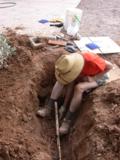
Two days later, after temporarily joining the pipes to allow water to flow into the house for some collection prior to turning it off while the repair was taking place and then allowing the immediate area to dry out, Paul was ready to remove sufficient dirt for the actual rejoining.
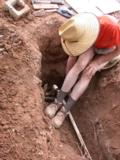
It took several hours to get the water to stop dripping out of the input pipe so that the surfaces to be joined were completely dry.

The next day Paul primed the two pipes (no residue of the characteristic purple color primer was seen) and then applied the gray adhesive. A large block and wedges were used to hold the joint in place during the curing phase. (The gray pipe to the left of the white water pipe encloses the electrical lines to the house and to the water irrigation control box.)

Noting how far down the input water line is below ground surface - in case of future problems.
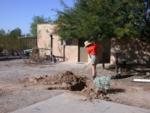
About 16 hours later, we turned on the water and saw no drips. After another day with all still well dry, the block and wedges were removed and a few hours later the dirt was replaced.

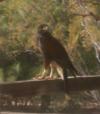 Our office window provides many interesting sights. Kitty was very much surprised one early afternoon in the first week of January to see a hawk on the hitching post outside. She and Paul had seen this hawk, or one of its relatives, on the roof antenna in the past and also telephone poles nearby, but never one so close on our own property. We had recently again visited the Arizona Sonora Desert Museum (ASDM) outside Tucson and viewed the raptor free flight exhibition which featured a family of Harris hawks; we wondered if this was such a hawk. Although there was only this one to be seen, much of the coloring is indicative of the Harris hawks we saw in flight.
Our office window provides many interesting sights. Kitty was very much surprised one early afternoon in the first week of January to see a hawk on the hitching post outside. She and Paul had seen this hawk, or one of its relatives, on the roof antenna in the past and also telephone poles nearby, but never one so close on our own property. We had recently again visited the Arizona Sonora Desert Museum (ASDM) outside Tucson and viewed the raptor free flight exhibition which featured a family of Harris hawks; we wondered if this was such a hawk. Although there was only this one to be seen, much of the coloring is indicative of the Harris hawks we saw in flight.
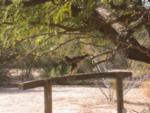
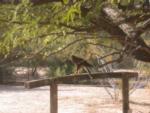
Lots of wing flapping and then the hawk took off, maybe to get wider view of prey on the ground.
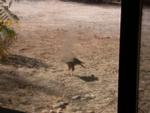
Almost exactly 24 hours later, Kitty was surprised and pleased when what appeared to be the same hawk returned and wandered closer to the office itself, only to be later disappointed when she realized that a dirty window obscured what would have been a great shot. Drats!
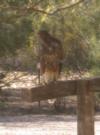
In this pic taken less than a minute later, the chest feathers are clearly visible and much lighter than those seen on the hawks in flight at ASDM. During the preparation of the photos for this page, Kitty located sites online showing various hawks and did find ones labeled as Harris that have these same markings. (Photos of hawks) When we visit ASDM again we'll try to remember to ask about the difference in chest feather coloring on these hawks.

After 3 attempts, Kitty finally got a decent timed photo of herself and Paul in their living room on January 8, 2006 with the ceiling lights dimmed very low so that the colorful winter decorative lights are picked up by the camera.
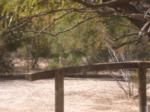 Kitty captured this nice sight of doves making good use of the hitching post outside our outbuilding to the west. More often they perch themselves on the wall that extends from the house westward when not in the nearby large mesquite tree which shades much of this area.
Kitty captured this nice sight of doves making good use of the hitching post outside our outbuilding to the west. More often they perch themselves on the wall that extends from the house westward when not in the nearby large mesquite tree which shades much of this area.
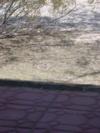
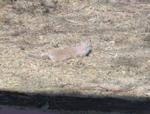 We hadn't seen any ground squirrels from soon after we arrived near the end of October until the middle of January. The temperatures had been on the mild side; Kitty never used a winter jacket at all (Paul never has on any winter stay in central AZ deserts) and rain was non-existent. Still, these animals apparently hibernated during those months. Maybe it's the length of daylight rather than temperature that signals this severe drop in metabolism. These pics were caught just 2 days after the first ground squirrel was spied near the brush pile further to the north - and s/he wasn't very active but rather just stayed stationary awhile and then disappeared out of sight in a couple of minutes. But within a few days, each individual we saw was scampering around as usual. Kitty "caught" this round-tailed ground squirrel just beyond our ramada on the north side of the house.
We hadn't seen any ground squirrels from soon after we arrived near the end of October until the middle of January. The temperatures had been on the mild side; Kitty never used a winter jacket at all (Paul never has on any winter stay in central AZ deserts) and rain was non-existent. Still, these animals apparently hibernated during those months. Maybe it's the length of daylight rather than temperature that signals this severe drop in metabolism. These pics were caught just 2 days after the first ground squirrel was spied near the brush pile further to the north - and s/he wasn't very active but rather just stayed stationary awhile and then disappeared out of sight in a couple of minutes. But within a few days, each individual we saw was scampering around as usual. Kitty "caught" this round-tailed ground squirrel just beyond our ramada on the north side of the house.

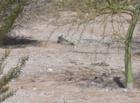 "Dirt bathing" is an interesting periodic animal activity (I've seen many a horse take one) in this area, including birds; Kitty was able to pictorially capture two about 100 feet from our kitchen window, using her regular lens at full telephoto. The one in the center is definitely a gambil's quail; the one in the left near corner (partially hidden by the creosote branch in the 2nd pic) may be the same, but we've seen doves dirt bathe also. (Interesting info on bird bathing and dusting.) Rabbits in the summer months regularly make wallows in the dirt under the planted (and irrigated) Texas Rangers - one of which is visible just to the left of the center gambil's quail - apparently as relief from the heat.
"Dirt bathing" is an interesting periodic animal activity (I've seen many a horse take one) in this area, including birds; Kitty was able to pictorially capture two about 100 feet from our kitchen window, using her regular lens at full telephoto. The one in the center is definitely a gambil's quail; the one in the left near corner (partially hidden by the creosote branch in the 2nd pic) may be the same, but we've seen doves dirt bathe also. (Interesting info on bird bathing and dusting.) Rabbits in the summer months regularly make wallows in the dirt under the planted (and irrigated) Texas Rangers - one of which is visible just to the left of the center gambil's quail - apparently as relief from the heat.
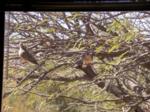
 Another odd sight from our office window was repeated visits by this very curious dove that attempted to "join us". Several times over a number of days he (it just seemed a male thing to pick the nesting spot) attempted to fly into the window, catching his claws in the screen, momentarily hovering or sitting as he's doing here appearing to ponder what he should do next. Moments after this shot, he tried again (Kitty's camera wasn't quick enough to catch the motion) but of course had no success. Perhaps with his mate watching and possibly signaling her annoyance at the folly, he gave up. We didn't see him again after this. Hopefully he made a suitable nest elsewhere.
Another odd sight from our office window was repeated visits by this very curious dove that attempted to "join us". Several times over a number of days he (it just seemed a male thing to pick the nesting spot) attempted to fly into the window, catching his claws in the screen, momentarily hovering or sitting as he's doing here appearing to ponder what he should do next. Moments after this shot, he tried again (Kitty's camera wasn't quick enough to catch the motion) but of course had no success. Perhaps with his mate watching and possibly signaling her annoyance at the folly, he gave up. We didn't see him again after this. Hopefully he made a suitable nest elsewhere.
MoreLife is Always "Under Construction"
Initially posted 6/2/06
Page last updated 12/2/07
Any questions, comments or suggestions regarding the content of this website
should be addressed at MoreLife Yahoo.
For comments on webpage format, contact Kitty
Antonik Wakfer

 Our office window provides many interesting sights. Kitty was very much surprised one early afternoon in the first week of January to see a hawk on the hitching post outside. She and Paul had seen this hawk, or one of its relatives, on the roof antenna in the past and also telephone poles nearby, but never one so close on our own property. We had recently again visited the Arizona Sonora Desert Museum (ASDM) outside Tucson and viewed the raptor free flight exhibition which featured a family of Harris hawks; we wondered if this was such a hawk. Although there was only this one to be seen, much of the coloring is indicative of the Harris hawks we saw in flight.
Our office window provides many interesting sights. Kitty was very much surprised one early afternoon in the first week of January to see a hawk on the hitching post outside. She and Paul had seen this hawk, or one of its relatives, on the roof antenna in the past and also telephone poles nearby, but never one so close on our own property. We had recently again visited the Arizona Sonora Desert Museum (ASDM) outside Tucson and viewed the raptor free flight exhibition which featured a family of Harris hawks; we wondered if this was such a hawk. Although there was only this one to be seen, much of the coloring is indicative of the Harris hawks we saw in flight.




















